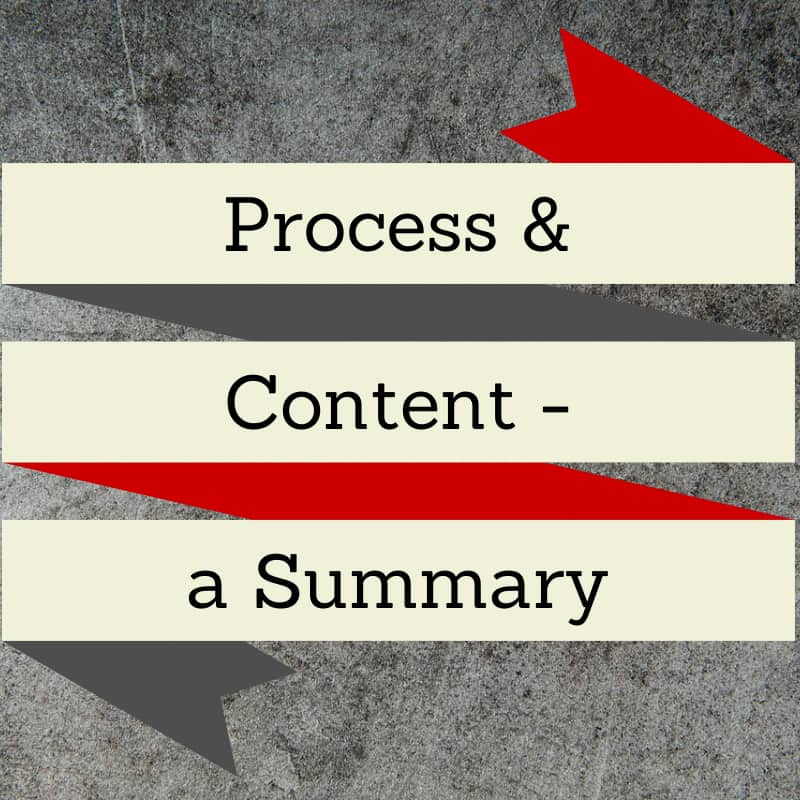I’ve been writing about this concept of Process and Content™ for several blog posts, and today I’d like to summarize the concepts. This post should provide a good reference piece for this principle. Perhaps most importantly, I’d like to challenge you to apply what you have learned to your personal and business life. John Maxwell describes the greatest gap is the gap between knowing and doing.
These concepts have transformed my leadership, and they can transform yours too, if you take steps to apply them in your life and business! Every leader can use this principle to increase the effectiveness of themselves and their team.
 1. The Ah Ha Moment
1. The Ah Ha Moment
Have you ever had an “Ah Ha” moment? A time when something finally made sense? Well, I had an Ah Ha moment regarding Process and Content. It was the first time that I experienced the effectiveness of Process.
You can read the whole story here. In short, I was a rolling out a new mission statement at our company when it happened.
My natural inclination at that time was to define the specifics and direction of an initiative (the Content), ask for some input from the team, and then go forward with rolling out my preconceived plan to the whole company.
This time, however, I took the time to really seek the perspectives and ideas of my employees. I changed my approach to how (the Process) I accomplished the task at hand. I interacted with my team in a more open, and intentional way (this is Process-oriented focus).
I was shocked by the response that I received during this process. I got incredible buy-in from the team, and developed a better mission statement in the process!
 2. Defining Content and Process
2. Defining Content and Process
I explained the specifics of Content and Process in my blog post on Transformed Leadership.
Content is the ‘what’ – or the results or end product of our efforts. An example of Content is the objective of an organization to develop a business plan to enter a new market. With Content, the focus is on things, managing those things, what we say and do — the final results of our work.
Process is the ‘how’ – the way we go about setting and defining the objective, and how we interact with our team to get the job done. In our example of the business plan, the way we actually defined the business plan would be the process side of the task. Process deals with who has input on the objective, and how we communicate with them.
The focus with Process is on people, leading them, enhancing relationships and how we say or do things.
If you’re like me, you tend toward Content, not Process. I like to focus on the task at hand, make decisions, delegate the supporting tasks, and get’r done! So lets look at this not-so-natural approach called Process.
 3. Process – How we do things
3. Process – How we do things
The first aspect to process is: How we do things. I relayed an interesting story about an executive that I know who turned a company around with his leadership. One of the main differences in the leadership style of him and his predecessor was the how they led their team.
The founding leader was controlling and dictatorial to his employees. When the new executive took the reins of the company, sales and profits soared! The new leader obtained vastly different results by seeking input from his key employees before making major policy and strategy decisions.
A key way to apply the principle of Process
Suppose you have a challenge or opportunity that arises in your business. Before you try to tackle the problem yourself, focus on the following three questions:
1. Who can help me make a better decision?
2. Who is going to have to carry it out?
3. Who will be impacted by it?
Next, gather an appropriate team to discuss the challenge or opportunity and resolve how it can most effectively and efficiently be addressed. Also, it’s important to resist the temptation to start finalizing your own solutions before the meeting.
 4. Process – How we say things
4. Process – How we say things
The second aspect to process is: How we say things. How we say something is often more important that what we say!
I wrote about this side to process in another blog post.
Here’s a Leadership Communication Truth:
If the way we say something is out of alignment with what we are saying, the way we say it will always dominate the communication.
 5. A Leadership Trap
5. A Leadership Trap
Don’t fall into the trap of thinking that you don’t have the time to worry about how you say things. If you don’t take time to work on your communication, you’ll spend a whole lot more time down the road trying the repair the damage of barking expedient commands.
How can we cultivate peak performance in order to maximize our success? The answer is simple but eludes most leaders. We obtain optimum results through participative decision-making and leadership.
 6. A Leadership Test
6. A Leadership Test
I have found that it helps me to occasionally have a gut-check regarding important areas of leadership. Here are some questions that you can ask yourself to determine how you leverage this important area of Process in your leadership.
Ask, “How well do I…” (and rate yourself, 1 to 5, 1=never, 2=almost never, 3=sometimes, 4=almost always, 5=always)
• Listen to others?
1 2 3 4 5
• Communicate with coworkers and direct reports?
1 2 3 4 5
• Understand, cooperate and collaborate with others?
1 2 3 4 5
• Praise and appreciate those around me?
1 2 3 4 5
If you really want to understand where you rank in the above areas, ask a trusted friend to gather anonymous feedback on these questions from your co-workers, supervisors and direct reports. The results have the potential to transform your leadership! (It did for me.)
 7. The Outcomes of using Process and Content
7. The Outcomes of using Process and Content
Why go through all the trouble of developing a Process and Content form of leadership? I’m glad you asked. At first, it may not seem worth the trouble. I can tell you, though, that this one concept has super-charged my leadership.
Here are some of the benefits: (you can see more detail here)
a) Highly motivated employees
b) Employees feel good about themselves because they have a sense of achievement, and enjoy receiving recognition for whatever has been achieved.
c) High performance teams
d) Customers appreciate being dealt with respectfully and are delighted because delighted employees enthusiastically serve them!
e) Employees who are part of the process feel their opinion is valued and are more likely to be committed to working within the team to achieve the results.
f) Employees who are invited to engage in the process are likely to gain a better understanding of the results they are expected to achieve and why it is important to achieve the results.
Will you close the gap?
Now, back to the gap that John Maxwell referred to. Our challenge as leaders, is to decrease the gap between what we know and what we do.
How did you score yourself in section six above? How would your spouse or co-workers score you for those questions? The answers to those questions only serve to define our starting point.
Here’s a handy list of links to my initial series of blog posts on Process & Content:
The bigger question is, “What are you going to do today to get better at leveraging ‘Process and Content’ in your business and personal life?”








